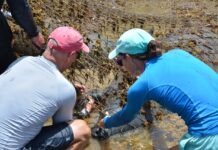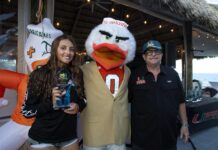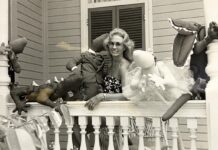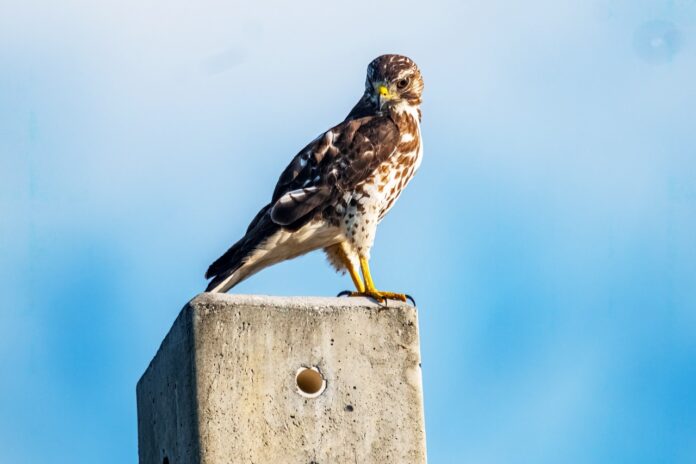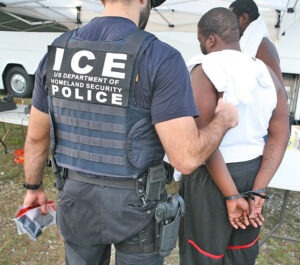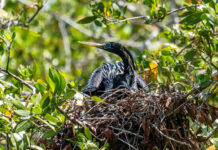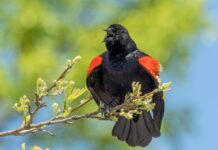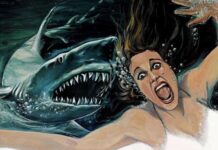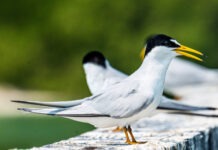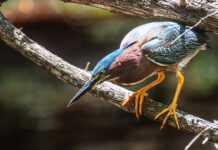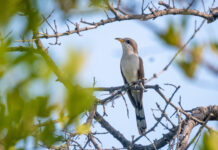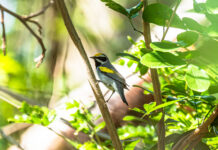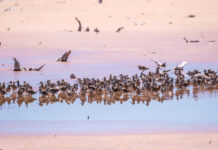It is difficult, as a birder, to think about chickens – or at least to know how to think about chickens properly. Is there a right way to do it? And is there a way to do it that might make sense to people who don’t spend a lot of time thinking about birds? I don’t know.
Chickens are biologically birds, but they are not wild. They live in this netherworld of classification.
I bring this up because I was out the other day, looking for birds, when I saw a broad-winged hawk perched high up on a concrete telephone pole over Atlantic Boulevard. He was glancing around, left, right and forward, but also generally down. He had a pretty tactical view of the neighborhood, and I imagined the world spilling out almost in 2D beneath him, like a topographical map.
Broad-wings are perch hunters. They feed by sitting in elevated positions and waiting for something slow and unsuspecting to wander beneath them. Which means it’s hard to tell when they are hunting and when they are loafing. Maybe there is no difference in their mind. To perch is to hunt. Opportunistic loafing.
Pondering too deeply about a random bird’s motivations is not going to get you any closer to the truth – it’s a locked-box mystery. But still, I lingered, if for no other reason than it is always somewhat edifying to see a hawk, to notice that there is often a world of life and death happening just at the periphery of our cushy day-to-day existence.
It took me a while to tune into all the cheeping. It was coming from chickens, or more specifically, chicken chicks, and it seemed like a lot of noise to be making with an apex predator sitting on a pole 30 feet overhead, just waiting for his moment. Did they have any clue he was up there?
I looked around for a while – under some bushes, through a fence. I finally found them, eight chicks and a hen, hiding in the deep shadows under a car, their safety enhanced by the 10-inch gap between tarmac and drive shaft. The world in 3D. A Cooper’s hawk might go under there after them at full speed, but broad-wings are – and I’ve probably said this way too many times – the lazy asses of the hawk world. They’d rather wait it out.
Alfred Lord Tennyson described nature’s ruthlessness as “red in tooth and claw,” a phrase that has largely become a cliche because it is so apt. Carnivorism is a large part of what makes the world go ’round, or at least what keeps the living things on the world alive as it goes around.
It’s important not to think of the natural world as a metaphor, especially for human behavior. Predator and prey both fill crucial roles in the natural world. The short version is: without predators, the world would be overrun with unchecked populations of prey animals. Without prey, predators would starve. It’s not pretty, but it’s true.
You could think of it as a zero sum game, where there is a winner and a loser, at least on a one-to-one basis. But in terms of population dynamics and species evolving, predators create a stronger prey population by (usually) taking the oldest, the slowest and the weakest, thus allowing the fittest to survive and pass their DNA forward.
The thing about chickens is, they are not wild animals; they are domesticated animals. Chickens are properly called red junglefowl. They evolved in the jungles of South Asia and Southeast Asia. It is thought that the initial impulse for pulling them out of the jungle and domesticating them wasn’t to raise them as food, but for betting and cockfighting. Using them as a hardy, low-maintenance, and genetically malleable food source was an afterthought.
It’s debated when exactly, or even roughly, this domestication happened, but current thinking is it was somewhere between 3,500 and 9,500 years ago. For a while there was a theory that domestic chickens may have had multiple genetic ancestors – green junglefowl among them – but most scientists now seem to believe in the one-ancestor – red junglefowl – theory.
There are currently an estimated 33 billion domesticated chickens in the world, with 1,600 different breeds. They are one of the more widely distributed animals on the planet. Ironically, the still extant population of wild red junglefowl in Asia is considered at risk of being overrun by the population of domesticated red junglefowl.
If you do a little Googling, you can find some overly confident statements about where Key West’s population of feral chickens came from – they all came from Cuba, they are all descended from fighting cocks, they were freed from their coops by Hurricane Georges. But there’s not a lot of documentation of any of that, just a lot of lore. And it should be pointed out that for the longest time, you could order chickens from the Sears catalog. Odds are they came
from multiple places and were allowed to go feral gradually, as people became more comfortable with the ease of acquiring their poultry pre-butchered at the grocery store.
Captive chickens can lay up to 300 eggs a year. Wild red junglefowl lay about 10 to 15 eggs a year. I’d be curious to know how many eggs a feral, free-roaming Key West hen lays in a year, but I can’t find any reliable studies.
What is certain is that the Key West population has exploded over the last few decades. Any Conch or long-timer will tell you that – though again, there really isn’t any data.
I’ve wondered over the last 10 or 15 years, with so much easy prey wandering the Key West streets, why some of our overwintering hawks – say, Cooper’s hawks, which have been steadily expanding their range down the Florida peninsula in recent years, or short-tailed hawks, which breed regularly in the state, haven’t extended their breeding territory into the Keys. And in the last couple of years both species have bred here at least once, though not regularly.
But even if either or both species colonize Key West and the Keys, it won’t put a dent in such a fast-growing population of chickens. There are just too many of them.
I don’t really have much by way of a conclusion here, just a lot of uncorrelated thoughts intermixed with more than a little curiosity about how this is all going to play out.
I’m generally pretty detached and hard-hearted about predators and their prey, but watching those chicks under the car the other day, I was torn between wanting to see something happen and not wanting to see anything happen.
I looked back up at the top of the pole and saw that the broad-wing was gone. A few minutes later the hen and her chicks emerged from the shadows and crossed the street.
Things had ultimately sorted themselves out. At least for the time being.





